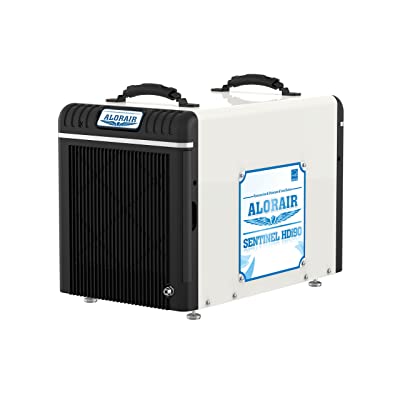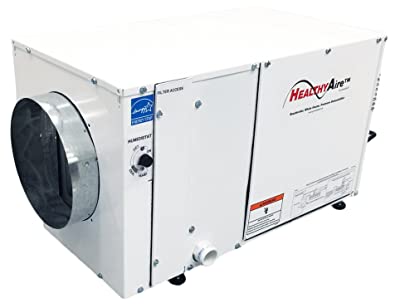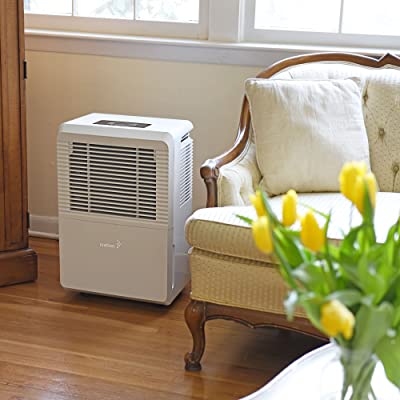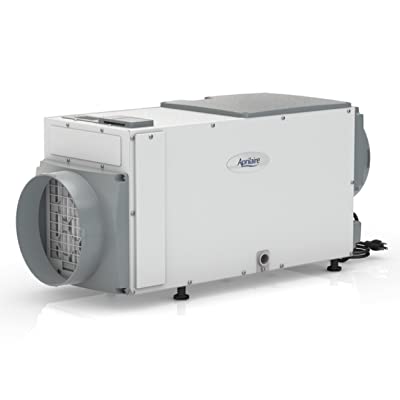Are you wondering, is a whole house dehumidifier worth it? If you care about clean and comfortable air, the answer is an unequivocal yes! Even if you have central air conditioning in your home, you may still find the humidity unbearable at times. Portable dehumidifiers help, but it gets costly to put one in every room, and can be a lot of work to empty all those tanks every day. The solution is a whole house dehumidifier that can be integrated with your current heating and cooling system. Here’s how to find the best whole house dehumidifier for your needs.
In many cases, central air conditioning can help to mitigate humidity in the air. But what if it isn’t hot enough to need cooling? Another issue is that the AC doesn’t typically run in naturally cooler environments like the basement or crawl space, yet they can still get dangerously damp. Here are some signs that a whole house dehumidifier could help in your home.
Growth
If you have noticed a musty smell in your home, odds are that the cause is mold and mildew growth. The dirt and dust that enters a home is comprised of many different types of biological particulates, including mold and algae spores. Environments in which the relative humidity is above 55% make the perfect place for that stuff to grow and multiply like crazy. That can cause bad smells, stains on your walls, ceilings, and floors, and above all, health issues. Mold and mildew is unpleasant in any home, but especially bad for allergy sufferers and people with other conditions that impact the immune system.
Rotting Wood
Wood can begin to rot if it is exposed to moisture for extended periods of time. Consistently high humidity is often the culprit. If you’re not sure if your home has been affected, the best places to look for rot are along window casings, in hardwood floors, and in the studs. Drywall can also rot with too much moisture. Rotting construction materials of any kind can weaken the structural integrity of your home, making it a dangerous place to be.
Allergies
Most of us tend to spend at least half of our time at home, but if you notice that you feel worse at home than other places, you might be suffering from allergies related to the air quality in your home. Too much moisture provides the perfect medium for allergens including pet dander, pollen, dust mites, and mold spores to spread throughout the home. A drier atmosphere goes a long way toward minimizing those issues.
What If There’s A Water Leak?
If there is definitely too much moisture in your home, but it’s caused by a plumbing leak rather than environmental conditions, a dehumidifier can help but it won’t solve the problem. Leaks in the slab, walls, crawl space, or foundation all contribute to humidity in the home and should be fixed by an expert as soon as possible. While your dehumidifier may keep the air feeling comfortable, if you put off the repairs, you will certainly end up with dangerous structural damage.
Whole House Dehumidifier Pros and Cons
So you are definitely uncomfortable at home, and the AC unit is struggling to work with all the humidity. You think a whole house dehumidifier might be the solution, but are wondering about the pros and cons of buying one. Stick with us.
What makes it different?
First, let us compare a whole house dehumidifier vs portable models. A whole house dehumidifier does basically the same job as a portable unit, in that it draws excess water from the air. Smaller dehumidifiers usually have a collection tank that must be emptied, but a whole home system has its own drainage that you don’t have to worry about. A ducted whole house dehumidifier is usually professionally installed to integrate with your current heating and cooling system (more on that later).
You may be wondering whether to purchase central AC or a dehumidifier, but the question isn’t really about a whole house dehumidifier vs air conditioner. In fact, these two tools work very well together. Central air conditioning can do a certain amount of dehumidifying, but it is more a side effect of its job rather than the main goal. In climates with really high humidity, AC will struggle to keep working through all that moisture. A whole house dehumidifier supports the AC system and helps to keep it running effectively for many years.
Pros of a Whole House Dehumidifier
Keeps you comfortable
Humans generally need a relative humidity in the range of 30-50% in order to feel comfortable. If the air is too damp, that moisture sticks to skin and prevents the body’s natural cooling process. We may feel wildly overheated, swollen, cranky, and frustrated with hair that seems to have tripled in volume. A whole house dehumidifier helps to keep you comfortable anywhere in the home.
Reduces cooling costs
AC units get really bogged down by excess moisture. They do their best under the circumstances, but the extra work can make your cooling costs skyrocket. With a whole house dehumidifier managing the excess humidity, your AC can work more effectively. This helps to ensure that your home’s entire HVAC system stays in top shape for many years, potentially saving on replacement costs as well.
Protects your property
Homes that are too humid inside will eventually sustain permanent damage. Paint may bubble up and your wood furniture could swell and warp. Excessive moisture is even prone to degrading walls and floors, leading to dangerous, not just uncomfortable, conditions.
Deodorizes air and promotes better health
When your dehumidifier pulls moisture from the air, it also takes out particulates that are trapped in the water. That serves to deodorize your space. Homes that are too humid tend to smell worse in general because they are hotbeds for the growth of mold and mildew. Getting the humidity in check is one of the best ways to freshen the air in your home.
Cons of a Whole House Dehumidifier
Upfront investment
We’ve only got one con – a whole home dehumidifying system can cost a bit to buy and have installed. It is definitely an investment, but one we think will provide a solid return. Weigh the initial cost of a whole home dehumidifier against the expense incurred in replacing household items that become damaged by humidity, including expensive furniture, walls, structural elements, and HVAC equipment.
Things to Look For
There are three main things to consider when choosing the best whole home dehumidifier for your space.
Capacity
Be sure to review the capacity rating on any model you consider, as this will help you understand how much water the dehumidifier is capable of taking from the air over a set period of time, as well as how much area it can cover. Make sure that you select a model that can handle both the amount of humidity in the air and the entire internal space of the house.
Energy Efficiency
In order to keep the power bills in check, you’ll want to look for an Energy Star rated appliance. Most are pretty efficient at this point due to regulations that dictate energy standards. But don’t be tempted to save a few bucks on a unit with poorer energy efficiency as you will definitely spend the savings and more in power costs.
Noise Level
It’s worth checking out the operating decibels of your new dehumidifier, especially if it will be located somewhere that borders a main living space. If your unit will be tucked away in a basement or crawl space, it may not be of too much concern, as whole house dehumidifiers typically don’t make more noise than an AC unit does. But some may be quieter than others and worth prioritizing if you’re sensitive to white noise.
Top 5 best Whole House Dehumidifier Reviews
AlorAir Basement/Crawlspace Dehumidifiers 198PPD

The AlorAir is a high end machine, built strong. It can easily dehumidify up to 4,000 square feet, pulling up to 90 pints of water per day at AHAM conditions. One of the nicest features is a hot gas defrosting system that allows the unit to work at temperatures as low as 36F. You will no longer worry about those wet winter days when thawing snow makes your home feel damp.
The coils benefit from internal corrosion protection, with an epoxy coating to maintain their ability to transfer heat for many years. Energy Star rated, the high-efficiency rotary compressor ensures maximum effectiveness at a low operating cost.
With an integrated heavy duty condensate pump, you’ll be able to drain the water wherever you like. All cables on the pump have quick connect plugs for fast and easy installation and maintenance, whether you do it yourself or get a professional.
And finally, an optional upgrade for this unit is a remote control that allows you to monitor relative humidity levels no matter where you are in the house. If you need to adjust settings, that’s easy, too. AlorAir is one of the top manufacturers for hard working products, and offers a five year dehumidifier warranty.
SPECS
- 15.8 x 24.8 x 13.8 inches
- 78.3 pounds
- Five year warranty.
PROS
- Hot gas defrost to work in low temps
- Durable construction
- Optional remote control.
CONS
-
- Questionable build quality
- Filter needs replacing on a regular basis
HealthyAire Dehumidifier Whole House Residential DH70 70 Pint

The HealthyAire Dehumidifier can handle a solid 70 pints per day of water at AHAM levels. It functions as either a standalone or integrated unit, and can be ordered with expert installation included if you prefer. Installation includes:
- * Disconnection and removal of any existing central dehumidifier
- * Mounting of one customer-supplied central dehumidifier to specified location
- * Reconnection of water lines, electrical lines, and HVAC integration
- * Mounting and connection of control dial
Note that larger or more complex projects could be subject to additional costs from the local contractor.
The built-in humidistat on this unit is as simple as could be, with range settings for humid, ideal, and dry. It contributes to the ease of operation, but may not be satisfying to people who want to set a precise level of humidity. You can’t beat the set-it-and-forget-it simplicity of this machine, though, and it should work quietly for you for years. The model is Energy Star rated, so it won’t break the bank with energy bills. Built of sturdy metal, it comes with a five year warranty on the compressor, but only two years on other parts.
SPECS
- 27.2 x 13 x 13 inches
- 65 pounds
- 5 years compressor; 2 years other parts.
PROS
- Energy Star rated
- Durable construction
- Installation may be ordered online along with product.
CONS
-
- Only basic controls
- Heavy
- May be difficult to fit into tight spaces.
Ivation 70 Pint Energy Star Dehumidifier – Large-Capacity For Spaces Up To 4,500 Sq Ft – Includes Programmable Humidistat, Hose Connector

This energy-friendly dehumidifier is a portable unit and not strictly what we think of in terms of a whole house dehumidifier. However, it can cover an incredible 4,500 square feet and pull a comparable 70 pints of moisture per day. It might be the right choice for you if you don’t want to mess with connecting your unit to existing ductwork and plan to move it around – the included casters and relatively light weight of 40 pounds makes this easy.
The Ivation has a lot of features and functionality that the HealthyAire lacks. Its bright LED display allows precise humidity and fan speed settings, for one. It also has a timer function, clean filter alert, auto defrost capability, and an auto restart function after power outages.
The unit has a 1.3 gallon collection bucket, but you can also can also attach a hose (purchased separately) to divert water down the basement drain. The filter is reusable – simply clean when needed and replace it.
SPECS
- 15.4 x 10.8 x 23.2 inches
- 39.7 pounds
- One year warranty.
PROS
- Drain hose available
- Light and easy to move
- Multiple features & digital display.
CONS
-
- Initial setup is a little bit tricky
- Hose may leak at the connection point
- Plastic rather than metal construction.
Ideal-Air Commercial Grade Dehumidifier Up To 60 Pint

Built to last, the Ideal-Air has comprehensive digital controls for precise settings. The interior workings are easily accessed through a hinged front panel, so it’s no struggle to remove and clean the replaceable filter. The metal exterior is powder coated to ensure a long and rust-free life. The heavy duty compressor helps to extract up to 60 pints of water from the air per day.
Other features such as the built-in defrost sensor (which allows operation down to 45 F) and auto-restart function contribute to the ease of operation. It is recommended to plug the unit in through a surge protector, as the circuit board can be damaged by power surges and is not covered under the warranty.
SPECS
- 22.5 x 15.1 x 27 inches
- 72.6 pounds
- One year warranty.
PROS
- Digital controls
- Ease of maintenance
- Built-in defrost to work in low temps.
CONS
-
- Fan has only one speed
- Lower end capacity at 60 pints
- Circuit board not covered by warranty.
Aprilaire 1850 Whole Home Pro Dehumidifier, Dehumidifies Up to 3000 Sq Ft, Removes Up to 12 Gallons (95 Pints) of Water/Day

This Aprilaire whole house dehumidifier makes the list because of its extremely high capacity of 95 pints per day, coupled with an Energy Star rating not matched by most other products – 4.5 pints/kilowatt per hour. Built with corrosion-resistant aluminum coils and a sturdy metal casing, you can count on it to go for years.
The unit is easy to install and to set up drainage. You may either direct water through a hose, or simply set the unit over a floor drain. Set the target humidity and pretty much forget about it, as the integrated sensor ably cycles the unit on and off as needed. It can also toggle between whole house and localized dehumidification, depending on whether or not your central air is running.
Aprilaire offers a five year warranty on their 1850 model, but only if it has been professionally installed in your home. It may not be the model for you if you plan to go it alone (unless you are also a professional), but professional installation is recommended in general to take full advantage of the features offered by your whole house dehumidifier.
SPECS
- 33 x 13 x 16 inches
- 70 pounds
- 5 year warranty.
PROS
- Pulls 95 pints per day
- Low energy consumption
- Supports AC by switching between whole house and local dehumidifying.
CONS
-
- May need an external fan to circulate air if not attached to ductwork
- No pump; gravity drained
- Warranty contingent on professional installation.
Misconceptions About Whole House Dehumidifiers
If you are stuck between several portable dehumidifiers and a whole house unit, we may be able to help by clearing up some misconceptions about whole house dehumidifiers. Then you can make your decision based on real info.
Myth #1: Whole House Dehumidifiers are more expensive than portable dehumidifiers
While it is true that whole house dehumidifiers are bigger, sturdier, and more costly off the shelf than portable models, they also last a lot longer and do a bigger job than any one portable.
Portables tend to run almost constantly because they are too small to effectively tackle high humidity levels. They work best in smaller, closed rooms for this reason. But a whole house dehumidifier is able to reduce the humidity level quickly and then shut off until it is needed again. It uses more electricity when it operates than a portable, but runs a lot less often.
You will likely need multiple portable dehumidifiers to manage all the humid areas in your home, and because they are chiefly constructed of plastic instead of metal, you will certainly have to replace your portables more often than a whole house system. In the end, the two options just about balance out in terms of purchase and operating costs.
Myth #2: Whole House Dehumidifiers are hard to install
One of the best features of a whole house dehumidifier is that it can integrate into your existing HVAC system. However, it doesn’t have to, and will work just fine if you decide to simply plug it in. The one complicating factor will be that you need to run a drain line. But this mostly means attaching a hose and routing where you need the water to go.
Sometimes water is drained into a utility sink, other times there is floor drain that can be used. Without either of those options, people will often route water up and out a window (make sure it drains away from the house). If your drain line will include a vertical section, make sure you get a dehumidifier with pump built in. This will direct water any which way. Without it, you’ll need to rely on gravity to guide the water from a higher to a lower point.
Myth #3: Whole House Dehumidifiers have special electrical needs
Don’t get caught up thinking that you’ll need an electrician to put in new wiring before you can have a whole house dehumidifier. Almost all of them operate very safely in a standard 3-prong electrical outlet. A few industrial models require a dedicated 20A circuit, but this is rare in a standard residential model. Only if you are buying your dehumidifier for a commercial building or a sprawling mansion will this be a consideration.
Myth #4: Portable units deliver higher performance
Once you start comparing them, it may appear as though portable dehumidifiers have a higher capacity than whole home models. This is because of how their ratings are reported. Notice that whole house models list two capacities: capacity at AHAM and capacity at saturation. The portable models only show their capacity at saturation. So what does that mean? Saturation refers to when humidity has reached the maximum possible level. AHAM means a typical humidity level, which obviously varies from place to place. But when you read a performance rating at saturation, it refers to a state which the machine will never experience (unless your home is flooded). It is easier to pull moisture when the air is saturated, though, so the rating makes it seem like you can count on that performance all the time – you can’t. AHAM is a more reliable rating because it relates to what you can expect at the humidity level actually encountered by the unit.
About Installation of a Whole House Dehumidifier
The best way to install a whole house dehumidifier is to tie it into existing return ductwork, though as we’ve already said, it doesn’t have to be done that way. If you would like the most efficient and seamless operation possible, it may be best to have an expert handle the job. That opens up multiple possibilities for you in terms of how the air flow is routed, and can even implement a fresh air option that pulls a certain amount of fresh outside air inside, only without pollen and other contaminants.
If you want to save some money on installation, you really only need to place the dehumidifier in your preferred location, set up the drain hose to direct water down a utility sink or floor drain, and plug it in. The manual should help you determine which settings are ideal for your space.
Installation Methods
Return-to-return
Often installers will use a return-to-return setup, which means that air is taken from the return plenum and routed into your dehumidifier. Then the dehumidified air is pushed back into the return closer to the air handler. This method helps avoid pressure imbalances because there’s no need to add a new return duct or return grille, and no new return ductwork needs to be fitted into the space.
Dedicated return
Another method adds a new return duct to the home that routes air to the dehumidifier. The drier air is then sent into the existing return plenum near the air handler.
About fresh air ventilation
If you are going to have a professional installation done, you should ask about having the crew enable fresh air controls. A whole house dehumidifier can function as a mechanical ventilation system which pulls fresh air into the home after filtering out pollen and particulates. This is great for clearing out cooking and body odors that get trapped in a closed up house.
First, the amount of fresh air your home needs is calculated based on multiple variables. The installers will then program the unit to bring in the perfect amount of fresh air from the outdoors. The air enters through a small duct, is passed through a filter, and then dehumidified. A professional can even program your dehumidifier to block fresh air when it is too cold or too hot outside. But who doesn’t like a gentle spring breeze when they can get it?
A note about energy costs
So is a whole house dehumidifier worth it? Remember when you install a whole house dehumidifier that you are doing so to improve the comfort and quality of your indoor air. It will cost something each month to keep that going. However, if you are suffering from excess humidity at home, the price is very much worth it.
You may not notice a huge spike in electric bills for the summer, because you are likely to be able to set the thermostat a bit higher. Drier air will feel more comfortable at a higher temp, allowing the AC to cycle off more frequently. Therefore we don’t expect that your energy costs will be staggering. In the winter, your dehumidifier will likely only run on days where the temperature has risen enough to cause significant snow melt.
Conclusion
Ready to make a major comfort upgrade to your home? We think that once you take the plunge, you will be so happy with the air quality inside your home that you’ll never want to leave. Allergy symptoms will abate, and that sweaty swollen feeling goes away. Your house will be the place to be for every summer gathering. So whether you plug it in yourself or have a professional do a fancy installation, you should now have the info you need to choose the best whole house dehumidifier for your space.




